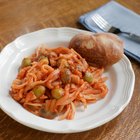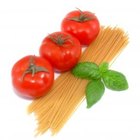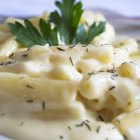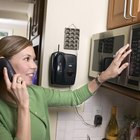
On days when your stove burners are fully occupied, countertop appliances can be a lifesaver. Whether you're preparing an especially complex recipe or making tonight's dinner while preparing for tomorrow's family reunion, the extra cooking capacity you gain from appliances, such as electric fry pans, can keep you from getting frazzled.
The Basics
Cooking pasta is a deceptively simple exercise. You salt some water, bring it to a boil and drop in your noodles. After the recommended cooking time, you take it out. In practice, there are some subtleties. For one thing, you need lots of water. It takes a gallon of water to cook a pound of pasta properly, giving the noodles lots of room to move around as the water swirls and boils. You should stir the pasta frequently to keep it in motion, so the noodles don't stick to each other or the bottom of the pot. Test for doneness regularly as you reach the end of the cooking time to ensure that the pasta's not getting overcooked and mushy.
Using Your Skillet
Using your electric skillet to cook the spaghetti doesn't change the fundamentals. You'll still need four quarts of water to cook a standard one-pound package of spaghetti, which is just about exactly the capacity of a standard 12-inch square skillet. If yours is extra-deep, or if it's one of the larger oval models, you'll have room to spare. Electric skillets are also thermostat-controlled, so the element starts and stops during your cooking time. To avoid that, set the cooking temperature at 275 to 300 degrees Fahrenheit. That's setting 4 or 5, if the skillet's marked with numbers instead of temperatures.
Preparation
Fill your electric fry pan to within a half-inch of the top, or to its "max fill" line if it has one. Add a tablespoon of salt to the water, cover the skillet with its lid, and bring it to a boil. Remove the lid and add your pound of pasta -- or less -- and then cook, uncovered, according to the directions on the package. When it's fully cooked but still firm and springy between your teeth, unplug the skillet and drain the spaghetti into a colander.
Final Tips
If you're serving your spaghetti right away, don't rinse it. The cooked noodles have a thin coating of starch that helps sauces cling to them. If you're going to let the spaghetti sit for a while and serve it later, feel free to rinse. That keeps the pasta from cooking any further and reduces the likelihood of it congealing into a solid lump of noodles. If you want to minimize your cleanup, you can heat sauce in the electric skillet and empty your colander of pasta into it. Toss the noodles until they're well coated with the sauce and serve the spaghetti immediately.
Related Articles

Can I Pour Hot Water in a Baking Dish ...

How to Fry Raw Spaghetti

The Best Way to Cook Spaghetti Noodles

How to Cook & Freeze Spaghetti Noodles

How to Make Crock-Pot Spaghetti

How to Make Spaghetti Noodles

When to Add the Noodles in a Crock Pot ...

How to Cook Spaghetti to Use the Next ...

How to Cook Lasagna Noodles Al Dente

How to Cook Whole Grain Pasta

How to Make Homemade Mac & Cheese

How to Cook Lasagna Noodles so They ...

How to Make Mac & Cheese Using Alfredo ...

How Long Is Leftover Spaghetti Good to ...

How to Boil Pasta Noodles

How to Cook Vegetables With Spaghetti

How to Cook Penne Rigate Noodles in the ...
How to Cook Large Amounts of Noodles ...

How to Cook Miracle Noodles in the ...
How to Cook Grits in the Microwave
References
Writer Bio
Fred Decker is a trained chef and certified food-safety trainer. Decker wrote for the Saint John, New Brunswick Telegraph-Journal, and has been published in Canada's Hospitality and Foodservice magazine. He's held positions selling computers, insurance and mutual funds, and was educated at Memorial University of Newfoundland and the Northern Alberta Institute of Technology.
Photo Credits
Jupiterimages/Creatas/Getty Images